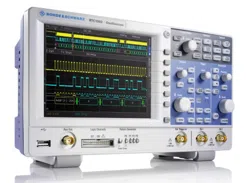Loading ...
Loading ...
Loading ...

Measurements
R&S
®
RTC1000
91User Manual 1335.7352.02 ─ 04
Pulse Width –
"Pulse Width –" measures the width of the negative pulse. A negative pulse consists of
a falling slope followed by a rising slope. The measurement identifies the two slopes
and calculates the pulse width from their time difference (t). The measurement requires
at least one complete period of a triggered signal.
Duty Cycle +
"Duty Cycle +" measures the positive duty ratio. Positive signal portions are identified
over a period and set in relation to the signal period. The measurement requires at
least one complete period of a triggered signal. The measured value Dty
+
is displayed
as a percentage of the signal period.
Duty Cycle –
"Duty Cycle –" measures the negative duty ratio. Negative signal portions are identified
over a period and set in relation to the signal period. The measurement requires at
least one complete period of a triggered signal. The measured value Dty
+
is displayed
as a percentage of the signal period.
Rise Time 90%, Rise Time 80%
Measures the rise time of the first rising slope in the display (t
r
, t
r80
). The rise time is the
time in which the signal rises from 10% to 90% or from 20% to 80% of its amplitude.
Fall Time 90%, Fall Time 80%
Measures the fall time of the first falling slope in the display (t
f
, t
f80
). The fall time is the
time in which the signal falls from 90% to 10% or from 80% to 20% of its amplitude.
σ-Std. Deviation
Measures the standard deviation of the signal amplitude in the display. The standard
deviation is deviation of a signal from its mean value. A low result indicates that the
values are close to the mean value. A higher result illustrates that the difference
between the values is greater.
Delay
"Delay" measures the time delay between the measurement source and the reference
source. The instrument searches for the slope of the measurement source that is clos-
est to the time reference. Then, beginning from this point, it searches for the nearest
slope of the reference source. This time difference is the measurement result. Press
"DELAY SETUP" to select measurement source, reference source and slopes.
Automatic Measurements
Loading ...
Loading ...
Loading ...
